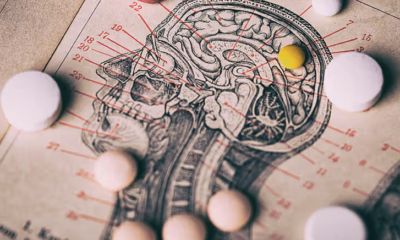Healthy Life
Exausted? These 11 foods May help

11 Foods to Eat to Beat Fatigue
Eating smaller portions and choosing minimally processed foods and whole foods may help reduce fatigue.
Your body runs off what you feed it. The best way to get the most energy from your food is to make sure you’re giving yourself the best food possible.
Some eating behaviors may also contribute to fatigue.
For instance, you might feel sluggish after eating a big meal. This is because your body is using its energy to digest the big meal instead of powering the rest of your body.
Consider eating several smaller meals throughout the day and going for a short walk after eating to help aid digestion and prevent sluggishness.
Here are 11 foods to help you beat fatigue.
- Unprocessed foods
Choosing unprocessed foods may help you feel more energized for longer periods.
Highly processed foods containTrusted Source ingredients like preservatives, additives, sodium, trans fat, and added sugars. Over time, these give your body fewer nutrients like vitamins and minerals needed to run efficiently.
Ingredients in ultra-processed foods may also cause more inflammation, which may eventually lead to medical conditions that could slow the body and cause fatigue.
Consider swapping out packaged or canned foods, candy, boxed meals, and pre-cooked meats for unprocessed whole foods, such as:
fruits and vegetables
lean proteins
low fat dairy products
legumes and beans
nuts and seeds
whole grains
- Fruits and vegetables
Fruits and vegetables are packed with essential vitamins, minerals, and nutrients that help fight fatigue and improve physical function. These nutrients also help your body run at peak performance, which helps fight fatigue.
Healthcare organizations like the Centers for Disease Control and Prevention (CDC)Trusted Source and the United Kingdom’s National Health Service (NHS) recommend eating at least 5 portions, or 400 grams, of fruits and vegetables daily.
Consider eating fruits and vegetables in any form, such as in-season or frozen.
Despite some claims that frozen fruits and vegetables aren’t as nutritious as fresh, research suggests that they’re convenient, affordable, and highly nutritious.
- Non-caffeinated beverages
Caffeine is OK in moderation.
In fact, some researchTrusted Source suggests caffeine may provide a short-term boost, and its antioxidant and anti-inflammatory properties may help fight chronic conditions.
However, drinking too much caffeine may lead to severe fatigue, headaches, and trouble sleeping.
The American Heart AssociationTrusted Source recommends keeping your caffeine intake to below 100 milligrams (mg) daily, which is the equivalent of two 8-ounce cups of coffee.
Drinking water, black decaffeinated coffee, and unsweetened tea may be the best options for preventing fatigue.
- Lean proteins
Lean proteins form an important part of a balanced diet and may help fight fatigue by:
maintaining muscle mass
preventing malnutrition
reducing systemic inflammation
slowing digestion
keeping you fuller for longer
preventing glucose spikes and crashes
The Dietary Guidelines for AmericansTrusted Source recommends adult males consume at least 56 g of protein daily and adult females 46 g.
Some lean proteins to consider adding to your diet may include:
animal proteins, such as chicken, eggs, turkey, and fatty fish
plant-based proteins, such as legumes, tofu, and soy products
Discover 16 high protein foods to add to your diet.
- Whole grains and complex carbs
Carbohydrates are an important macronutrient. They’re the primary source of energy for your body.
However, it’s important to choose whole grain foods and complex carbs, as these are full of beneficial fiber and are digested slowly by the body, providing long-lasting energy.
Refined carbs, on the other hand, are quickly digested and may lead to a quick energy crash.
Consider choosing complex carbs like fruits, vegetables, and whole grains instead of white breads, pastas, cakes, and sugar-sweetened beverages.
- Nuts
Nuts are a great food source to help fight hunger, manage body weight, and prevent fatigue. Consider adding the following nuts to your diet:
almonds
Brazil nuts
cashews
hazelnuts
pecans
walnuts
Consider choosing raw, unsalted versions for the perfect mid-afternoon snack.
- Water
Drinking water is essential for optimal functioning of the body.
Although water doesn’t provide energy in the form of calories, it helps facilitate the energetic processes in the body, which is an energy boost in itself.
The Academy of Nutrition and Dietetics recommends adult males consume 15.5 cups (3.7 L) of water daily, and adult females 11.5 cups (2.7 L).
Consider sipping on water throughout the day or swapping out sodas, coffee, and other drinks for a glass of water.
- Vitamins and supplements
Vitamin deficiencies are a common cause of fatigue.
Consider speaking with a healthcare professional if you think you may have a vitamin deficiency. They could provide a proper diagnosis and recommend appropriate supplements and daily vitamins, if necessary.
- Bananas
A 2012 studyTrusted Source compared bananas to carbohydrate sports drinks in cyclists who needed sustained energy for their long rides. The researchers found that the banana offered just as much fuel to the riders as the drink.
Bananas are packedTrusted Source with potassium, fiber, vitamins, and carbohydrates that provide a big boost of natural energy.
Plus, bananas are often less than a dollar per fruit, and that’s a price you can’t beat for so much extra energy.
- Oats
Oats pack a punch of fiber and even a littleTrusted Source protein, which may provide long-lasting energy and prevent fatigue. Plus, it’s good for people who experience blood sugar spikes and drops with other processed breakfast cereals.
Choose plain, steel-cut, or old-fashioned oats, as they’re not filled with extra sugar.
You can then control what you add to them, such as milk, a little honey, and some mixed berries.
- Seeds
Like nuts, seeds may provide a convenient source of prolonged energy thanks to their carbs, healthy fats, and fiber.
For instance, a 2022 study found that athletes who consumed a sports gel with chia seeds experienced an improved ability to take in and use oxygen during physical activity, potentially improving their overall performance.
A 2020 study also found that flaxseed helped reduce mental fatigue in children and adolescents with obesity compared to puffed wheat.
To boost your energy levels, consider adding chia, pumpkin, sunflower, and flax seeds to smoothies, salads, and yogurts.

Healthy Life
Is There Such a Thing as a ‘Migraine Brain’?

Some small studies have suggested that people with migraine may have some detectable brain differences compared to people who don’t have this neurological condition.

Migraine is often used as shorthand for a severe headache, but the term “migraine” actually refers to a neurological condition that affects about 39 million people in the United States.
Research and imaging studies have suggested that certain structures and functions of the “migraine brain” might differ slightly from those of the “typical” brain. More definitive research may eventually provide insight into the nature of migraine headaches, as well as other common migraine symptoms like migraine aura and sensitivity to light.
While it’s too early to draw any conclusions from the existing research, it’s possible that migraine may be associated with minor injuries to brain tissue. This possibility only underscores the importance of developing new migraine treatment and prevention options.
Brain differences in people with migraine
Studies using advanced neuroimaging techniques, such as functional magnetic resonance imaging (fMRI), are helping researchers understand more about how migraine develops and how the condition affects brain structure and function over time.
Some small studiesTrusted Source have noted varied differences in the brains of people with episodic and chronic migraine headaches.
Chronic migraine is defined as having headaches at least 15 days per month, while episodic migraine involves migraine headaches 14 or fewer days per month.
But researchTrusted Source suggests that this dividing line may not adequately address the complex nature of migraine, which may exist on a spectrum between episodic and chronic episodes.
Several research studies that used advanced neuroimaging techniques have detected differences between the brains of people with migraine compared to people without migraine. But the studies were all very small, and the results varied.
Pons
The pons is part of the brainstem, the region that connects the base of the brain to the spinal cord. The pons is responsible for several unconscious brain functions, including sleep and breathing.
In a 2019 study involving 64 people, researchers found that participants with migraine tended to have weaker function connectivity between the posterior pons and the left superior parietal lobe, the left temporal gyrus, and the left middle frontal gyrus. The reason for this difference was unclear, but the researchers did suggest that a deficit in pain processing could play a role in migraine.
Perivascular spaces
Perivascular spaces are fluid-filled passageways in the brain that play a role in fluid regulation and drainage. There are a lot of unanswered questions about the relevance of these spaces in neurologic, inflammatory, and vascular conditions. But researchers believeTrusted Source that the normal function of perivascular spaces is important to brain health.
A very small 2022 study on migraine noted a handful of cases where MRI images revealed a slight enlargement of the perivascular spaces in a region of the brain called the centrum semiovale. Many other conditions and factors, such as age, play a role in the shape, size, and number of perivascular spaces, so there is not nearly enough evidence to suggest a connection to migraine. But connections could be explored in larger-scale studies at some point in the future.
Hypothalamus
The hypothalamus is a part of the brain that manages hormones and other body systems, including sleep, hunger, sex drive, blood pressure, and temperature.
A 2020 study suggested that the hypothalamus-brainstem network might also play an important role in the migraine brain. The study found heightened activation of the hypothalamus during the headache phase of episodic migraine, suggesting that migraine headaches could originate in the hypothalamus.
Other parts of the hypothalamus appear to play a role in migraine chronification, which is the transition from episodic migraine to chronic migraine.
Pain network
The brain’s pain network, also known as the pain matrix, includes several brain regions, including the thalamus, anterior cingulate cortex, basal ganglia, and prefrontal cortices.
A 2021 studyTrusted Source suggested that people with migraine may have less connectivity and greater segregation among the regions of the pain network compared with people who don’t have migraine.
Cortical thickness
The brain’s cortex is the outer layer of the cerebrum, the largest region of the brain. The somatosensory cortex region of the brain, located in the parietal lobe, is responsible for processing pain and many other sensations.
Some small studies have found increased thickness in people who have migraine compared with those who don’t. This development may also explain why people with migraine also experience other symptoms, such as jaw or neck pain.
-

 Uncategorized11 months ago
Uncategorized11 months agoWhat Causes Unexplained Weight Loss?
-

 Uncategorized11 months ago
Uncategorized11 months agoJuiciest Turkey Recipe Ever
-

 Uncategorized11 months ago
Uncategorized11 months agoGov Ron DeSantis Caught On Camera Yelling At Students For Wearing Face Masks
-

 Recipes11 months ago
Recipes11 months agoClassic Roast Beef
-

 Uncategorized11 months ago
Uncategorized11 months agoTrump Aide Accused of Seeking Bribes to Promote Potential Cabinet Picks
-

 Uncategorized11 months ago
Uncategorized11 months agoTreating Migraine and Severe Migraine
-

 Uncategorized11 months ago
Uncategorized11 months agoAmazon Workers in Over 30 Countries Take Coordinated Action on Black Friday
-

 Healthy Life11 months ago
Healthy Life11 months agoIs There Such a Thing as a ‘Migraine Brain’?
